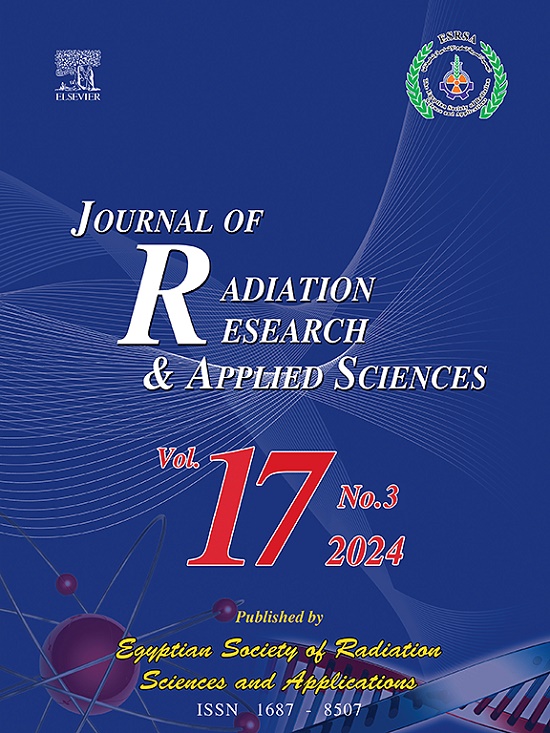Effects of thermal radiation on TiO2-Cu/water hybrid nanofluid: A finite difference discretization
IF 1.7
4区 综合性期刊
Q2 MULTIDISCIPLINARY SCIENCES
Journal of Radiation Research and Applied Sciences
Pub Date : 2024-11-01
DOI:10.1016/j.jrras.2024.101173
引用次数: 0
Abstract
This article aims to discover the double diffusive convection in TiO2-Cu/Water hybrid nanofluid. The impacts of heat generation and chemical reactions are also considered in the presence of a magnetic field. A collection of hybrid nanofluids of titanium oxide (TiO2) and copper (Cu) with a nanoparticle volume fraction of size equal to 0.05 is taken. The governing equations of the infinite vertical plate flow model, the non-dimensional governing equations, were solved by the explicit finite difference approach of the Dufort-Frankel method, which is employed numerically in MATLAB. To illustrate the main features of the solution, numerical calculators and graphs are used to illustrate the characteristics of fluid stream velocity, heat, and mass transfer under dissimilar parametric values. The primary findings and significance of this study indicates that Skin friction increases with increasing values of mass Grashof number, thermal Grashof number, and thermal radiation, while its intensifications decline with increasing values of magnetic field and Schmidt number. This study also discusses the limitations and challenges of utilizing hybrid nanofluids in practical applications, providing valuable insights for effective decision-making.
热辐射对 TiO2-Cu/ 水混合纳米流体的影响:有限差分离散化
本文旨在发现 TiO2-Cu/Water 混合纳米流体中的双重扩散对流。文章还考虑了磁场存在时的发热和化学反应的影响。研究收集了纳米粒子体积分数(j)等于 0.05 的氧化钛(TiO2)和铜(Cu)混合纳米流体。采用 Dufort-Frankel 方法的显式有限差分法求解了无限垂直板流模型的控制方程,即非维控制方程,并在 MATLAB 中进行了数值计算。为了说明求解的主要特征,使用数值计算器和图表说明了不同参数值下的流体流速、传热和传质特征。本研究的主要发现和意义在于,随着质量格拉肖夫数、热格拉肖夫数和热辐射值的增加,皮肤摩擦会增加,而随着磁场和施密特数的增加,其强度会下降。本研究还讨论了在实际应用中使用混合纳米流体的局限性和挑战,为有效决策提供了宝贵的见解。
本文章由计算机程序翻译,如有差异,请以英文原文为准。
求助全文
约1分钟内获得全文
求助全文
来源期刊

Journal of Radiation Research and Applied Sciences
MULTIDISCIPLINARY SCIENCES-
自引率
5.90%
发文量
130
审稿时长
16 weeks
期刊介绍:
Journal of Radiation Research and Applied Sciences provides a high quality medium for the publication of substantial, original and scientific and technological papers on the development and applications of nuclear, radiation and isotopes in biology, medicine, drugs, biochemistry, microbiology, agriculture, entomology, food technology, chemistry, physics, solid states, engineering, environmental and applied sciences.
 求助内容:
求助内容: 应助结果提醒方式:
应助结果提醒方式:


